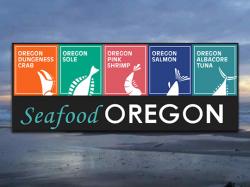Oregon Seafood Boom Hits 23 Year High
June 6, 2012 | 4 min to read

Any way you fillet it, Oregon’s commercial seafood and fishing industry had an outstanding year in 2011. For many fisheries, both the volume harvested off the Oregon Coast and the corresponding dollar value were the best in decades. A total harvest value exceeding $145 million for all Oregon fisheries has given coastal economies from Astoria to Brookings a much needed shot-in-the-arm.
What makes the numbers more impressive is the sustainable manner in which Oregon’s seafood is being harvested. Quite simply, there are plenty of fish left in the sea.
“This is the healthiest I’ve seen the ocean off the Oregon Coast in many decades,” says Nick Edwards, a long-time pink shrimp fisherman based in Charleston.
The Oregon Department of Agriculture, which has worked for years to promote Oregon seafood in export markets, is also excited about the current shape of the state’s fisheries.
“We have seen the continual evolution of Oregon’s seafood industry, where harvest and processing have combined with sustainable management to add value to the catch while allowing future generations to provide a product that is in sync with the marketplace,” says Oregon Department of Agriculture Assistant Director Dalton Hobbs. “A great deal of credit goes to the seafood commodity commissions that have provided dollars for research, education, and promotion in a successful effort to add value to what is harvested off our coast.”
Seafood OREGON is the name given to a consortium consisting of the Oregon Dungeness Crab Commission, the Oregon Trawl Commission, the Oregon Salmon Commission, and the Oregon Albacore Commission. Nick Furman, who serves as director of Seafood OREGON, says recent statistics prepared for the Oregon Department of Fish and Wildlife and the Oregon Coastal Zone Management Association indicate 2011 was the best, dollar-wise, in 23 years.
“We continue to remind fishermen that it’s not the pounds of fish that you take to the bank, it’s the dollars that you take to the bank,” says Furman. “All this speaks well for the health of the ocean, it speaks well for the management schemes presently in place that ensure we have sustainably-harvested stocks. The resulting evidence is the increase in pounds of fish harvested and dollar value.”
Last year, 285 million pounds of fish and shellfish were landed in Oregon, up from 216 million pounds in 2010. Meanwhile, four Oregon fisheries have received coveted Marine Stewardship Council (MSC) certification ensuring they are well managed, sustainably-harvested, and environmentally-neutral. Those fisheries include pink shrimp, Dungeness crab, albacore, and Pacific whiting.
“While the volume of fish coming in has increased, it is not happening at the expense of healthy fisheries and the stocks available to us,” says Furman.
Most Oregon fisheries enjoyed higher prices for what was caught. Combined with the higher volume harvested, the dollar value of Oregon landings increased to $145 million last year from $105 million in 2010. That’s about 44 percent above the annual average of the past 10 years.
“Oregon is doing something right and it is represented by healthy stocks, good volume, and prices that are going through the roof because of the global economy and worldwide demand for seafood,” says Furman.
As is the case with agricultural commodities, Oregon fisheries last year had both winners and losers. Fortunately, the winners outweighed the losers.
The pink shrimp fishery had its best season in 19 years, with 48 million pounds of high-grade shrimp harvested off the Oregon Coast and a dollar value to the fishing fleet of $24.6 million. Fishermen and processors have benefitted from the catch, but there is also a bigger demand for Oregon pink shrimp in the export market, which is bringing in new dollars to coastal communities.
It was another strong year for Oregon Dungeness crab, which normally represents 30 to 50 percent of the total value of all seafood landed in Oregon in a given year. The value in 2011 hit $44 million- another strong year for Oregon’s official state crustacean. Again, export demand in Asia has helped push ex-vessel prices up to unheard of levels.
“We are already over $40 million this season with three months to go,” says Furman, who also serves as administrator of the Oregon Dungeness Crab Commission. “The big story right now is price. The average price for the season to date is a record-high $3.37 a pound, eclipsing last year’s total season average price of $2.30.”
Albacore tuna landings, at 9.5 million pounds, were considered average last year. But thanks to high demand, the price paid at the marketplace drove the dollar value up to $18.7 million, a 33-year high.
A couple of Oregon fisheries didn’t have quite the banner year of others. Salmon landings totaled about 2.4 million pounds, slightly lower than 2010, although its price in the marketplace was slightly higher last year.
“Salmon was a bit disappointing,” says Furman. “Last year was the first time in several years that trollers got to fish the Oregon Coast for salmon. Everyone was optimistic, but the numbers were down a bit- the fish simply didn’t show up as much as expected. This year, there is a better harvest quota and everyone is keeping their fingers crossed.”
The sardine fishery also had a downturn with a harvest value of $3.2 million down from $5.3 million in 2010. The volume just wasn’t there, with Oregon landings only about 25 percent of its high mark of 2005.
Nonetheless, ports along the Oregon Coast are feeling good about the seafood and fishing industry’s 2011 resurgence, and optimistic about what the rest of 2012 will bring.
“The total picture for last year was great, and we’re seeing some continued evidence of the same level of activity this year,” says Furman.
That’s good news for not only the coastal economy, but the state’s economy as a whole.
For more information, contact Nick Furman at (541) 267-5810 or Bruce Pokarney at (503) 986-4559.
Source: Oregon Department of Agriculture
